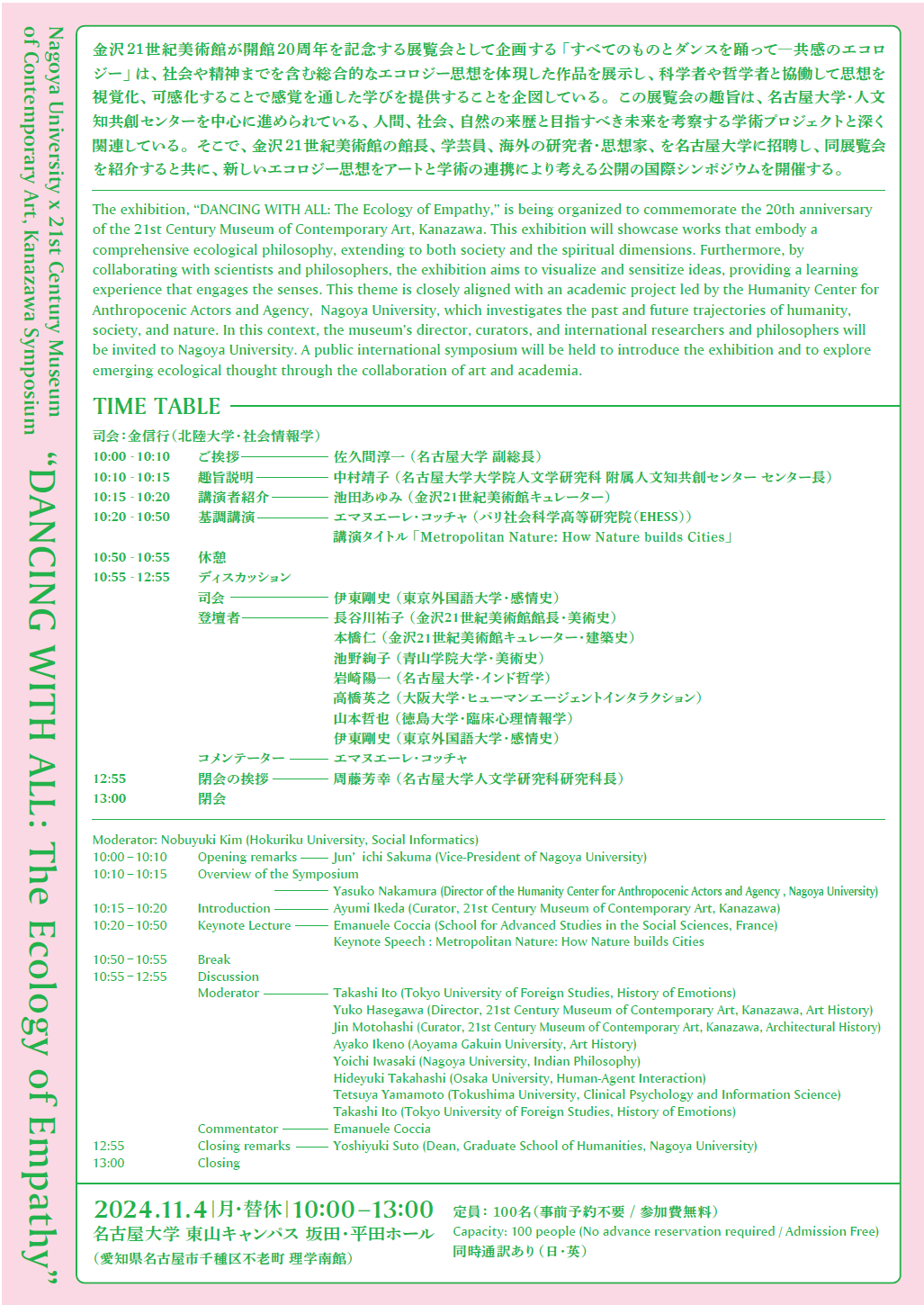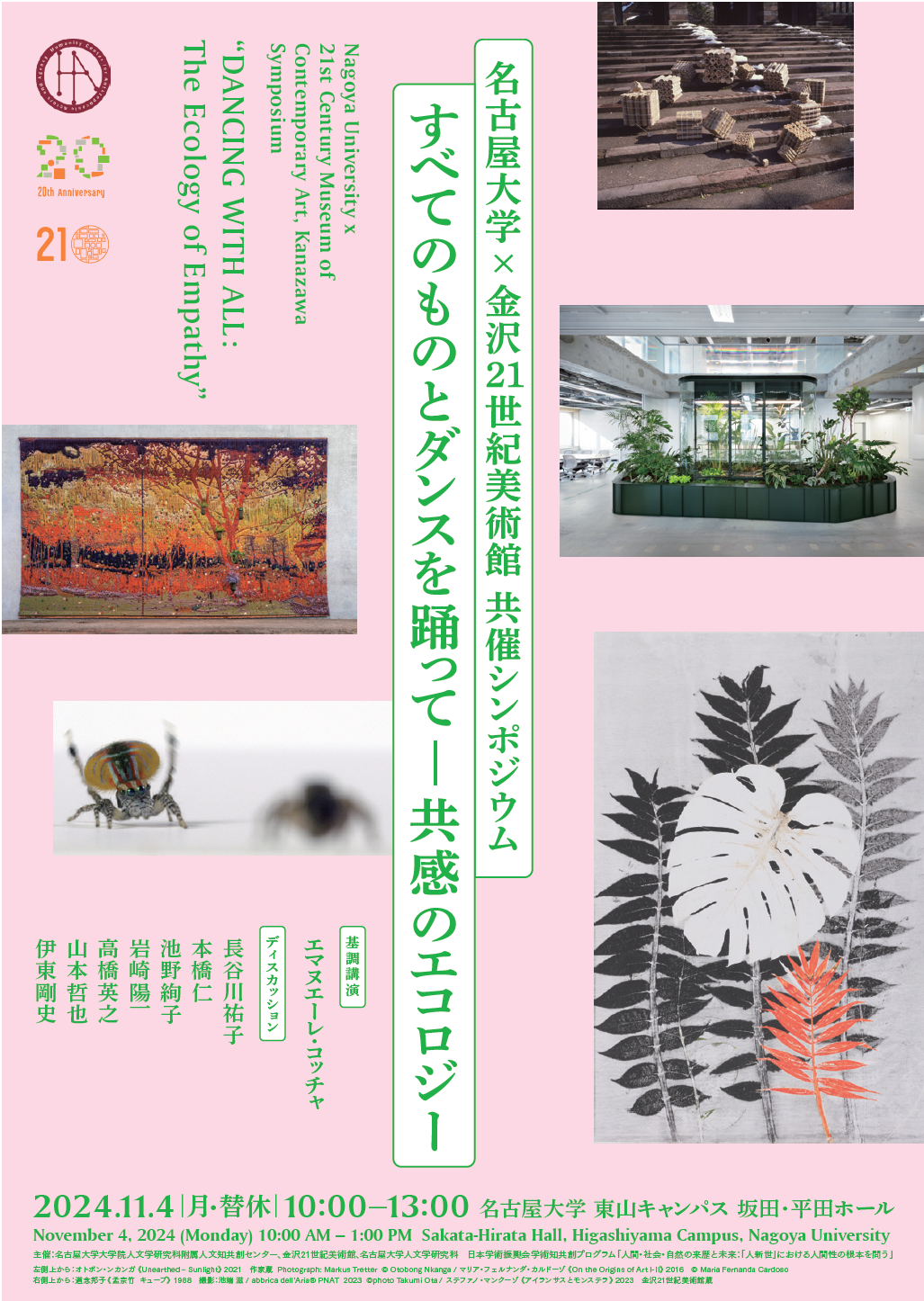🌟First Half
On November 4, 2014, Nagoya University and the 21st Century Museum of Contemporary Art, Kanazawa, co-hosted an international symposium titled “DANCING WITH ALL: The Ecology of Empathy.” at Sakata-Hirata Hall, Higashiyama Campus, Nagoya University. This symposium was held in conjunction with the exhibition of the same title, which had opened on November 2 at the museum. Following a keynote lecture by Emanuele Coccia of the École des Hautes Études en Sciences Sociale (EHESS) Paris, Hasegawa Yuko, director of the museum, curator Jin Motohashi, five members of the project team gave presentations in their respective fields of expertise.
At the beginning of the symposium, Jun’ichi Sakuma, Vice President of Nagoya University, delivered the opening remarks. He expressed his hope that this symposium—bringing together researchers from diverse fields beyond the arts and humanities under the theme of “An Ecology of Empathy”—would serve both as a platform to communicate the significance of the project to society and as a fruitful venue for collaboration between art and academia.
Next, Yasuko Nakamura, the Principal Investigator, explained the purpose of the symposium. She referred to Friedrich Hölderlin’s phrase, “Poetically, humans dwell” (Dichterisch Wohnet der Mensch), and stressed the need to understand human activities—through which people form flexible relationships with others via language, sound, and rhythm—as a dance between humans and things, resonating with others through bodily sensation and movement. She also defined the shared core issue between the project’s goals and the exhibition at the 21st Century Museum of Contemporary Art, Kanazawa.
Following that, Emanuele Coccia delivered a keynote lecture titled “Metropolitan Nature: How Nature Builds Cities.” Using the game “Pokémon” as an example, he illustrated how children learn to engage with nature through play, mediated by high-tech devices such as the Pokédex and Poké Balls. He demonstrated that the spiritual connection between humans and nature is continuously mediated by art and technology. From this perspective, he discussed the role of museums as spaces where people and nature interact.
The exhibition subtitled “Ecology of Empathy” presents a vision in which the museum functions like a city, providing a space for symbiosis where all living things share the same rhythm and “dance” together, rather than merely displaying themselves to one another. Emanuele Coccia stated, “What we need now is not technology for speaking, but technology for seeing.” He proposed a new ecological philosophy—the theme of this symposium,suggesting that by seeing through the eyes of others, we can open up nature as a space for empathy beyond our own bodies.
(Authorship: Akane Hayayanagi, 2nd-year Master’s student, Graduate School of Humanities, Osaka University)
🌟Second Half
After Emanuele Coccia’s keynote lecture and a short break, the other speakers shared their insights on the symposium’s theme from the perspective of their respective fields.
・Yuko Hasegawa — Director of 21st Century Museum of Contemporary Art, Kanazawa, Art History
Director Hasegawa first introduced her role as curator of this symposium, explaining how her encounter with Professor Coccia led to the theme of “dance” for this symposium. She also emphasized that one important role of an art museum is to be a place that seeks common ground, rather than focusing only on differences. She then explained the exhibition’s concept, using the diagram included in the exhibition pamphlet. Touching on some of the actual works on display, she introduced how dance is performed with other entities within this exhibition.
・Jin Motohashi — Curator of 21st Century Museum of Contemporary Art, Kanazawa, History of Architecture
Motohashi spoke on the topic “The Ecological Paradigm: From an Architectural Perspective,” drawing on insights from architecture. Using the recent trend of wooden constructions as an example, he pointed out that the association among “environment, nature, and wooden architecture” can be overly simplistic, and emphasized the need to reconsider whether it truly represents coexistence. He mentioned Team ZOO as an example of practitioners who pursued wooden architecture aiming for coexistence with nature even before the recent trend. Introducing their architectural works, he discussed their roots and suggested that the issue of proportion with nature was inherently contained within Modernist architecture. He then stated that a future challenge is the need to re-examine how the essential concept of nature is contained within the inorganic nature of Modernist architecture.
・Ayako Ikeno — Aoyama Gakuin University, History of Art
Professor Ikeno shared her thoughts on the exhibition, as well as the following three points. First, regarding “reconsidering materialism,” she expressed her impression that the works in this exhibition similarly possess the same significance as the Italian art movement Arte Povera (Poor Art), which challenges the “abundant art” benefiting from capitalism by reexamining capitalism and anthropocentrism. Second, she explained her current research on art based on breathing and the atmosphere, touching on the influence of Professor Coccia’s Philosophy of Plant Life. Finally, leading into the discussion, she raised the issue of “Empathy and Politics.” Referring to Maria Fernanda Cardoso’s work “On the Origin of Art I-II” and drawing on her own impressions after seeing a spider dance, she posed the question: Could the problem of empathy with others also be connected to politics between different species?
・Yoichi Iwasaki — Nagoya University, Indian Philosophy
Iwasaki presented poetry from Kalidasa’s work Shakuntala under the theme “Dancing with All Things—Shakuntala.” He explained that Kalidasa’s work, where humans gather with plants, animals, the sun, the moon, and various other entities, connects to this theme of “dancing with all things.” He then actually recited the poem in the original Sanskrit, explaining that this was necessary because translation was not enough for full understanding. Finally, he noted that while plants are not typically considered companions of humans, who possess souls, in Indian thought, plants are also “living beings” that “breathe.” He stated that Indian thought reveals a vision where various beings, including plants, dance together.
・Hideyuki Takahashi — Osaka University, Human-Agent Interaction
Takahashi presented on the relationship between humans and robots under the title “The Mysterious Adventures Created by the Dance Between Humans and Machines.” Focusing on the relationship between humans and robots, he highlighted that humans not only want robots to “do things for them,” but also want to “do things for others.” He introduced robots that fulfill this desire and research results utilizing them. He proposed that striking a balance between “wanting to do for others” and “wanting others to do for us” is crucial. He suggested that by controlling this balance through communication as a medium, we can create a future where humans and robots (machines) exist in an equal relationship. He stated that creating systems that avoid dependence on machines and establish an equal relationship between humans and machines would lead to sharing others’ subjective worlds, expanding one’s own world, and even creating new cultures.
・Tetsuya Yamamoto — Tokushima University, Clinical Psychological Informatics
Yamamoto gave a presentation titled “The Ecology of Empathy Dancing with Digital Technology: Toward an Era of Resonance Between Humans and Virtual Characters,” discussing the relationship between humans and virtual characters. He began by highlighting a similarity between dance and technology: “transcending boundaries to bring people together.” As an example of what the fusion of digital technology and dance can offer humans, he introduced “AR Awa Odori,” where participants dance the Awa Odori alongside virtual characters. Regarding the impact of living with virtual characters, he also introduced flexible, conversational virtual characters developed using generative AI. He reported findings from studies on the effects of interacting with these characters, noting that conversations led to reduced distress and increased feelings of happiness. Finally, he pointed out the possibility of resonance occurring between humans and virtual characters as a future research direction.
・Takashi Ito — Tokyo University of Foreign Studies, History of Emotions
Ito focused his remarks on the symposium title, ‘Dancing with All Things: An Ecology of Empathy.’ He first highlighted the particle ‘to’ in the title, discussing how replacing this ‘to’ with other words might alter the relationships within the theme. Next, he addressed “empathy,” pointing out that it possesses various aspects where elements like inclusion and diffusion are two sides of the same coin. Finally, focusing on “dance,” he suggested that the repetition and gemination in phrases like “dance the dance” create a sense of rhythm and pause, thereby recalling the continuity of life.
Following presentations by each speaker, a discussion period was held. First, Coccia responded to the speakers’ remarks . He raised the question of what significance collaborations like this symposium between universities and museums hold, and pointed out that universities tend to academically integrate diverse elements into a single framework. He stated that rethinking new forms of knowledge is essential at the very beginning of such collaborations. As an example, he suggested that philosophers should not only publish books and papers as they do now, but also explore the necessity of expressing themselves through other forms, languages, and media.He also noted that the relationship with robots and virtual characters discussed by Takahashi and Yamamoto is similar to the way humans interact with pets like dogs and cats, in which they try to express themselves in ways that align with human psychology. He then argued that to achieve “dancing with all things,” it is necessary to create a new culture, a global culture and language that are common to all humans, and that universities must become the platform for this.
Finally, questions from the participants and discussions among the speakers took place. The symposium ended with closing remarks delivered by Professor Yoshiyuki Suto (Dean of the Graduate School of Humanities, Nagoya University).
(Authorship: Motoki Tanaka, First-year Doctoral Student, Graduate School of Humanities, Nagoya University)

